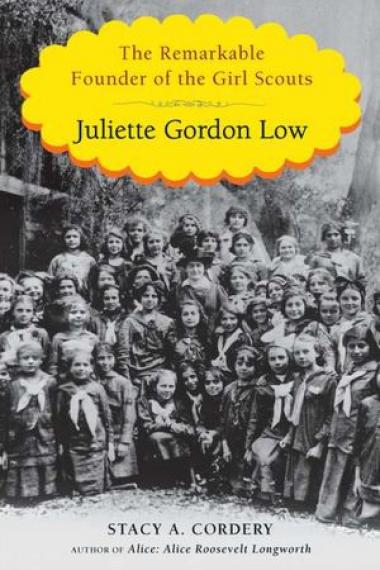
Leader of the Pack
JULIETTE GORDON LOW:
The Remarkable Founder of the Girl Scouts.
By Stacy A. Cordery.
Viking. 382 pp. $28.95

JULIETTE GORDON LOW:
The Remarkable Founder of the Girl Scouts.
By Stacy A. Cordery.
Viking. 382 pp. $28.95
Millions of American women have worn a Girl Scout uniform, including Hillary and Chelsea Clinton, Lucille Ball, Mariah Carey, and Sandra Day O’Connor. Aside from those ubiquitous boxes of thin mint cookies, the organization, which today claims more than three million members, is synonymous with the best values of American culture, including devotion to public service and chipper self-sufficiency. It owes its existence to the vision of a vibrant if eccentric promoter of opportunities for girls, as historian Stacy A. Cordery recounts in Juliette Gordon Low: The Remarkable Founder of the Girl Scouts.
Low, known all her life as Daisy, was born in Savannah in 1860, on the brink of the Civil War, to a Confederate captain and his Yankee wife. As a young woman, she grew smitten with William Mackay Low, a rich squire with a likewise geographically divided pedigree: His mother was a local belle and his father was British. After months of Southern romance, “Willy” left for Oxford, where he was too busy carousing with other women to answer Daisy’s letters, though he spent every summer with her. Once he decided to settle down, however, the two became engaged—Daisy evidenced the fine breeding he required in a bride, and she was attracted to his wild streak.
Already having lost most hearing in one ear because of an improperly treated infection, Daisy suffered a freak accident at their wedding in 1886 when a grain of rice thrown by a celebrant lodged in the same ear and led to complications in both ears that left Daisy almost entirely deaf. Seeking treatment for the disability, as well as for tuboovarian abscesses that left her childless, preoccupied Daisy as Willy returned to his libertine ways.
Living most of each year in London, and manipulating their life until he was Daisy’s only priority, Willy became “everything to her and simultaneously despised her for it,” Cordery writes. Unfortunately, she fails to provide much insight into the personalities of Willy and Daisy, whetting our interest without giving satisfaction. The book, though gracefully written, lacks the bite of Cordery’s biography of Alice Roosevelt Longworth—probably because Daisy was a nicer person and because her life produced a comparative dearth of primary sources.
In 1905, just after Daisy had accepted the inevitability of divorce, her husband died suddenly. With the help of her family, she fought successfully to claim the inheritance Willy had left to his lovers and friends instead of to his wife. By 1908 Low was accompanying relatives and friends to Pompeii, Egypt, Africa, and India. But once back in her London home, she would complain of boredom and loneliness. Yet when she filled her house with guests, she would disappear until the frantic servants found her upstairs. (One wishes Cordery had plumbed such eccentricity—or buried hostility—more deeply.)
Low’s life changed in 1911, when, at the age of 51, she met General Sir Robert Baden-Powell, a Renaissance man who had recently founded the Boy Scouts in England. Having long felt that women were treated as secondclass citizens (especially when, as in Low’s case, the member of the “weaker sex” had a physical disability), Baden-Powell convinced her that she could achieve for girls what he had for boys. Low headed home to Georgia, where she telephoned a friend to say, “Come right over. . . . I’ve got something for the girls of Savannah and all America.”
Low organized the first troop meeting of 18 girls in her hometown on March 12, 1912. When the United States declared war on Germany five years later, she and her troops registered voters, rolled bandages, planted victory gardens, learned Morse code, and made vast numbers of “smokeless trench candles” with which soldiers could warm their rations. At last, Juliette Gordon Low had found herself useful.
The organization grew quickly; within eight years, it numbered over 67,000 members. Low remained at the helm until shortly before her death from cancer in 1927. As a leader, she was far from perfect. She was frequently bossy and unwilling to share authority with others. Her eccentricity coupled with her deafness could make her whimsy appear more imperious than charming. But her belief that women could overcome any adversity convinced her that public service was a perfect fit for typically underoccupied girls and women.
Initially unsure about the wisdom of racially integrating the Girl Scouts at the troop level, Low formed the first all-black troop in 1917. Other racially and culturally defined troops soon followed. In 1956, Martin Luther King Jr. lauded the Girl Scouts as “a force for desegregation”: Troops were frequently integrated by then. Today, Low’s ethos of acceptance endures. This past October, a Denver Girl Scout troop told seven-year-old transgender Bobby Montoya that he could not join. But a national spokesperson for the organization later said the decision had been a mistake: “If a child is living life as a girl . . . we welcome her. We do not require proof of gender.”